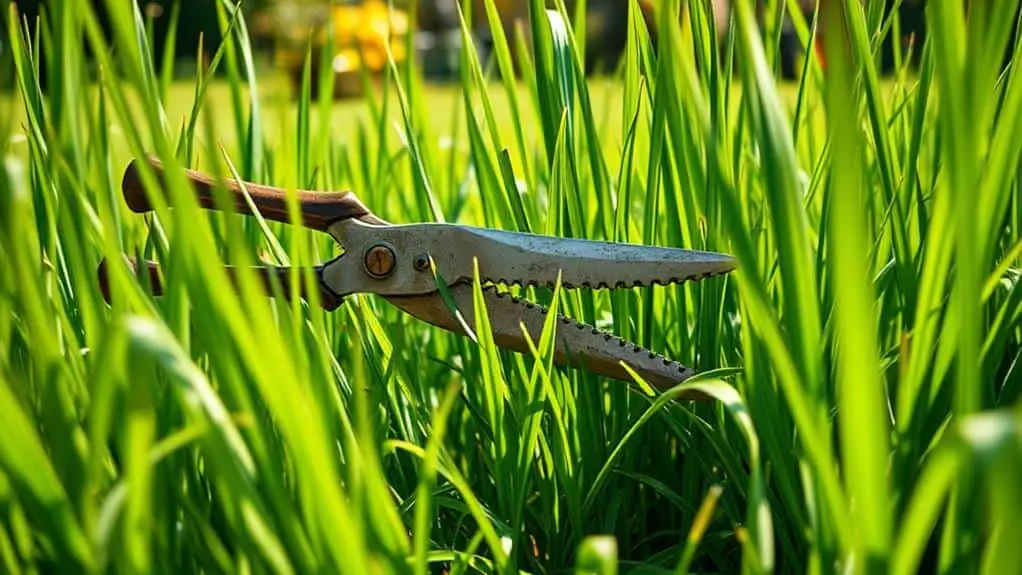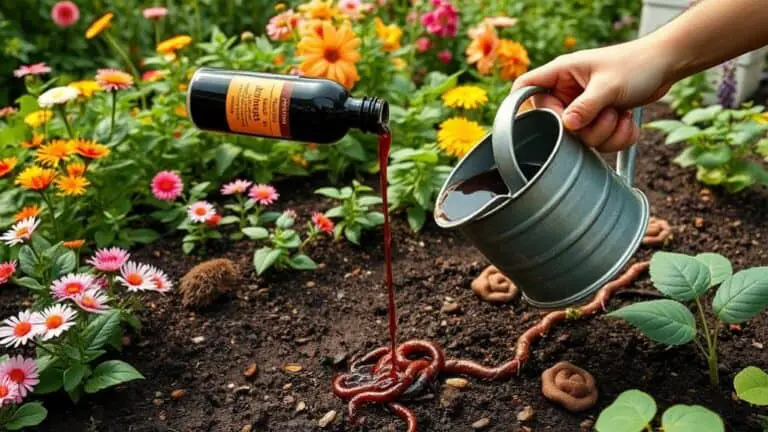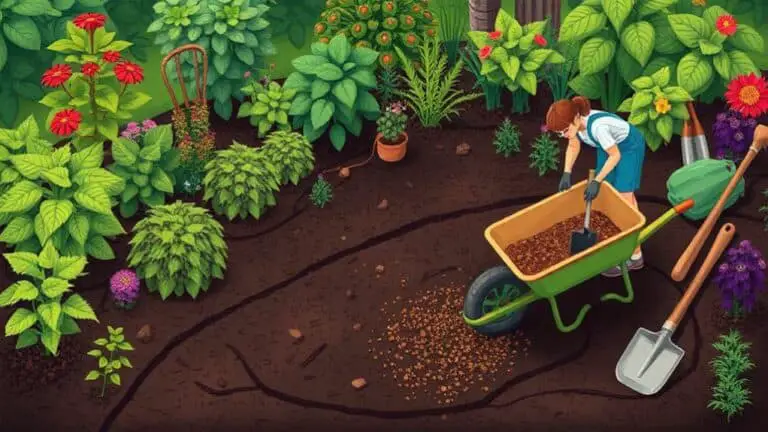Hack To Trim Overgrown Grass In A Pinch
When you're staring at an overgrown lawn with limited time, there's a practical hack that can save you from a lengthy ordeal. Imagine using a string trimmer to tackle the tall grass sections quickly, followed by an old kitchen knife or scissors to fine-tune the edges around delicate areas. Start by evaluating the height of the grass, adjusting the trimmer's speed for ideal cutting. But don't rush to clean up just yet—there's more to this process that guarantees a perfectly trimmed lawn and prevents future overgrowth.
Tools and Materials Needed
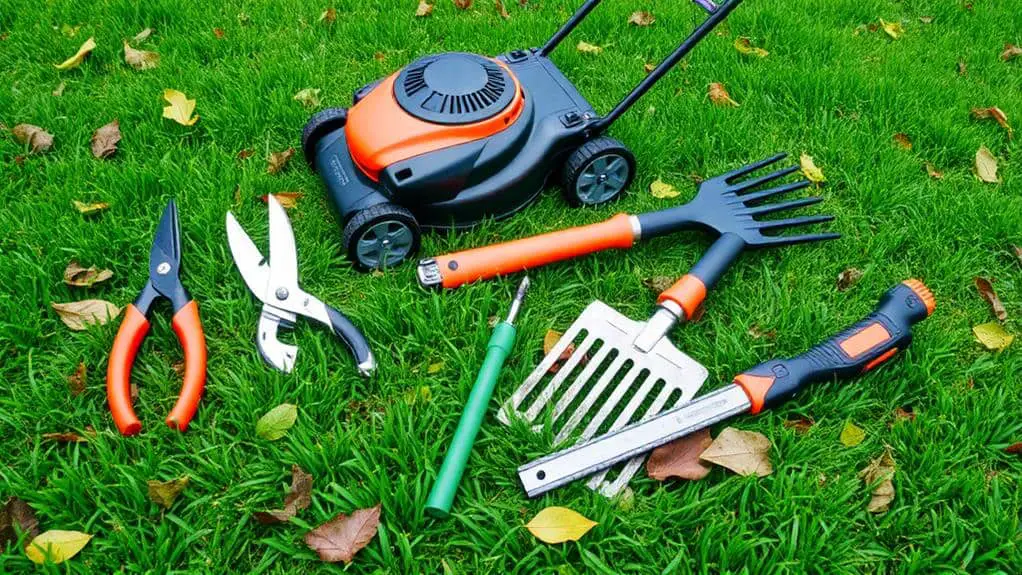
When you're tackling overgrown grass, having the right tools and materials makes all the difference.
To effectively trim overgrown grass, start with a string trimmer or weed eater. These tools quickly cut down tall grass and reach tricky spots. For more delicate areas, use an old kitchen knife or scissors for precise trimming.
Don't forget to wear safety goggles to protect your eyes from flying debris.
After trimming, a rake is essential to gather up the grass clippings, ensuring your yard stays neat. Finally, have trash bags or compost bins ready for proper disposal of the clippings.
Following these tips will make your grass trimming task easier and more efficient, leaving your lawn looking great.
Initial Grass Assessment
First, take a good look at your lawn to assess the height of the grass.
Taller grass might need a string trimmer or even a hedge trimmer for easier cutting.
Next, check how dense the grass is and look out for any obstacles like rocks or roots that could affect your trimming.
Determine Grass Height
To start trimming overgrown grass effectively, you need to assess its height and health.
Begin by measuring the grass with a ruler or tape measure. Overgrown grass typically exceeds 6 inches, signaling it's time for a trim.
Additionally, observe the type of grass you have. Cool-season grasses should be between 2.5 to 4 inches, while warm-season varieties thrive at 1.5 to 3 inches.
Check for any yellowing or browning, as this indicates stress and may need more care.
Finally, evaluate the surrounding environment for obstacles like rocks or debris to guarantee safe trimming.
This initial assessment helps you plan an effective and efficient trimming strategy, ensuring your lawn looks its best.
Identify Grass Density
Identifying grass density is a crucial step in your initial grass assessment. Start by checking how thick the grass is and if there are any weeds. Dense grass means you'll need more powerful cutting tools for an effective trim.
A handy hack is to trim your grass when it exceeds one-third of its ideal height. This keeps it healthy and stress-free.
Don't forget to look for signs of disease or pests, as these issues can change grass density and might need special treatments first.
Also, consider the type of grass you have. Different species grow differently, so knowing your grass type helps you choose the best trimming technique.
With these tips, you'll be ready to tackle any overgrown lawn confidently!
Cutting With a String Trimmer
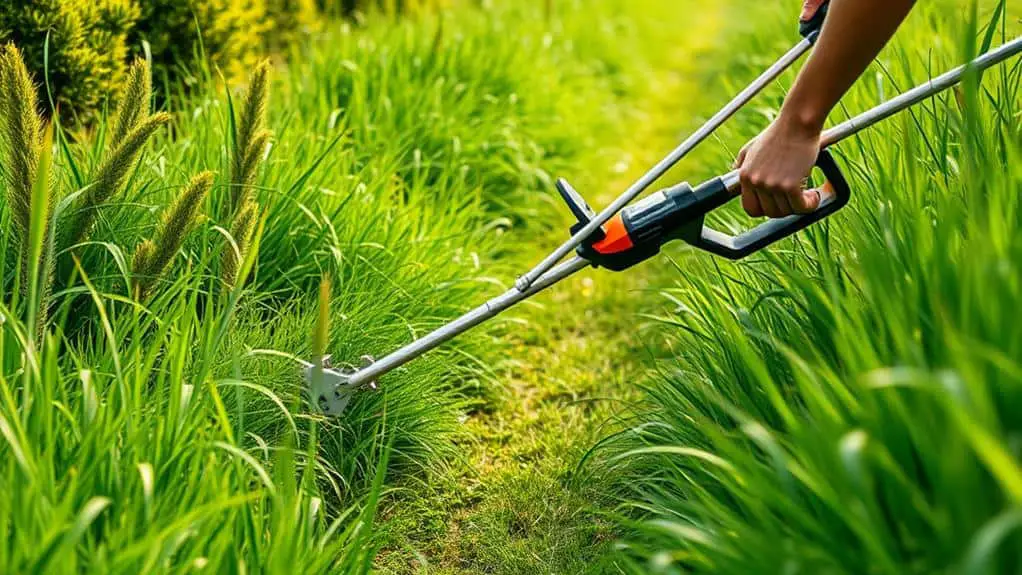
Using a string trimmer is a fantastic way to tackle overgrown grass, especially in those hard-to-reach spots where a lawn mower struggles. To start, assess the height and density of the grass. This hack to trim overgrown areas involves adjusting the trimmer's speed settings for peak cutting efficiency. Hold the trimmer at a comfortable angle, letting the cutting head glide just above the ground for an even cut. Use sweeping or circular motions to cover all areas evenly. Always check and replace the trimmer line to maintain its effectiveness. Here's a quick guide:
| Step | Action |
|---|---|
| 1. | Assess grass height and density |
| 2. | Adjust trimmer speed settings |
| 3. | Hold at a comfortable angle |
| 4. | Use sweeping/circular motions |
Following these tips will help you trim like a pro.
Fine-Tuning With Scissors
While a string trimmer handles large swaths of overgrown grass, sometimes you need a more precise tool for those tricky spots. That's where fine-tuning with scissors comes in handy.
For tight spaces or around delicate flower beds, scissors offer the control you need to trim grass in a pinch without harming nearby plants. Use sharp, sturdy scissors with blades 6-8 inches long for better leverage and less hand fatigue.
Regularly sharpen and clean your scissors to avoid grass sap build-up. This practice not only guarantees a neat appearance but also promotes healthier grass growth by allowing air and sunlight to reach the underlying blades.
Incorporate this technique to keep your lawn looking its best.
Raking Up Clippings
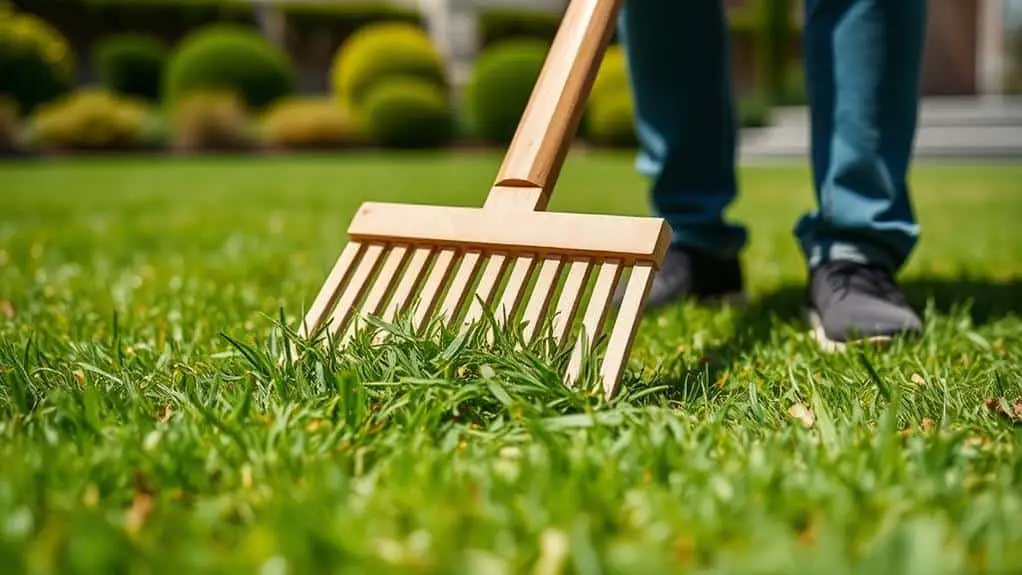
After trimming your overgrown grass, raking up the clippings is vital for both aesthetics and lawn health.
Immediately raking helps maintain visibility so you can see the progress you've made and prevents clippings from getting in your way.
Grab a sturdy rake to efficiently gather the cut grass into neat piles, making your cleanup faster and more organized.
As you rake, consider placing the clippings on a tarp or in a trash bag for easy collection.
This step is important because it reduces the risk of lawn diseases by allowing better air circulation.
Raking guarantees your grass isn't suffocated, keeping it healthy and green.
Proper Disposal Methods
Proper disposal of grass clippings is essential to maintaining a healthy lawn and adhering to local regulations.
First, check your local guidelines for yard waste. Many areas have specific rules for grass clippings and other organic waste.
Consider composting at home; it's a fantastic way to recycle nutrients back into your garden.
If you must dispose of them, use biodegradable bags, which are often accepted in yard waste programs and help reduce landfill impact.
If you're using a landfill, make sure to separate yard waste from regular trash.
Finally, look for community yard waste drop-off sites that may offer free disposal services.
Essential Safety Precautions

When trimming overgrown grass, taking essential safety precautions guarantees you stay injury-free and your equipment remains in good condition.
It's vital to follow these tips to make your trimming experience safe and effective:
- Wear safety goggles: Protect your eyes from flying debris and grass clippings.
- Use gloves: Prevent cuts and abrasions on your hands while handling tools.
- Clear the area: Remove obstacles like rocks and branches to reduce injury risk and equipment damage.
- Dress appropriately: Avoid loose clothing that could get caught in the trimmer or mower.
Additionally, always keep children and pets away from the work zone.
This guarantees everyone stays safe while you focus on the task at hand.
Following these simple steps will help you trim safely and efficiently.
Routine Maintenance Tips
Having covered the necessary safety precautions, let's focus on routine maintenance tips to keep your lawn in top shape.
Establish a regular mowing schedule, ideally every week or bi-weekly, to prevent your grass from becoming overgrown. Set your mower height to around 2.5 to 3 inches, depending on your grass type, like Kentucky bluegrass or fescue.
Use mulching techniques by leaving grass clippings on the lawn. This helps suppress weeds and retain moisture. Monitor the weather and avoid mowing when it's wet to prevent soil compaction.
Fertilize every 6 to 8 weeks during the growing season to promote healthy growth. By following these tips, you'll keep your lawn healthy and avoid overgrowth problems.
Benefits of Regular Trimming

Regularly trimming your lawn offers numerous benefits that go beyond mere aesthetics. By keeping your grass at a healthy length, you're promoting its overall health and ensuring your yard remains a private oasis.
Here's how regular trimming helps:
- Healthy Growth: Prevents thick thatch buildup, enhancing nutrient absorption and root health.
- Pest Control: Reduces hiding spots for insects and rodents, keeping your lawn pest-free.
- Curb Appeal: Boosts property value by creating a neat, attractive look.
- Disease Prevention: Improves air circulation, reducing stagnant moisture and lawn diseases.
A well-trimmed lawn is easier to maintain, allowing you to enjoy a beautiful, private space without the hassle of overgrowth.
Regular trimming makes lawn care simpler and more effective.
Preventing Future Overgrowth
To keep your lawn looking its best and prevent future overgrowth, start by establishing a regular mowing schedule. Mow every week or bi-weekly to maintain ideal grass height. Adjust your mower's cutting height based on your grass type to support healthy growth. Use grass clippings as mulch to suppress weeds, preventing them from contributing to overgrowth. Keep an eye on the weather; after heavy rain, you might need to mow more often to control rapid growth. Finally, follow a fertilization schedule suited to your grass type. Over-fertilizing can cause excessive growth, making lawn care harder.
| Tip | Benefit |
|---|---|
| Mowing Schedule | Prevents overgrowth |
| Adjust Cutting Height | Promotes healthy growth |
| Mulch Grass Clippings | Suppresses weed growth |
| Monitor Weather | Controls rapid growth |
Frequently Asked Questions
How to Cut Severely Overgrown Grass?
Start by evaluating the height and density of the severely overgrown grass. Use a string trimmer for initial cutting, followed by scissors for precision. Rake and collect clippings immediately. Proper grass maintenance guarantees visibility and cleanliness.
What Is the Easiest Way to Remove Overgrown Grass?
To remove overgrown grass easily, use a string trimmer first. For precision, grab an old kitchen knife or scissors. Consider grass alternatives like ground covers or artificial turf to minimize maintenance and keep your yard looking neat.
How to Edge an Overgrown Lawn?
To edge an overgrown lawn, start by ensuring it's dry. Use a string trimmer for initial lawn maintenance, then a stick edger to define edges. Sweep debris into piles, use a blower, and consider washing down the area.
How Do You Cut Tall Grass Without Clumping?
To cut tall grass without clumping, use effective mowing techniques. Employ a string trimmer, mow when dry, adjust cutting height, and use a mulching mower. Regularly rake or collect clippings to avoid suffocating your lawn.
Conclusion
You've got this! By using a string trimmer for the tall grass and scissors for the fine details, you can quickly get your lawn looking neat. Remember to rake up clippings for better air circulation and compost the waste if you can. Regular trimming keeps your lawn healthy and prevents overgrowth. Follow these simple steps, and you'll find maintaining your lawn isn't as tough as it seems. Keep up the great work, and happy gardening!

